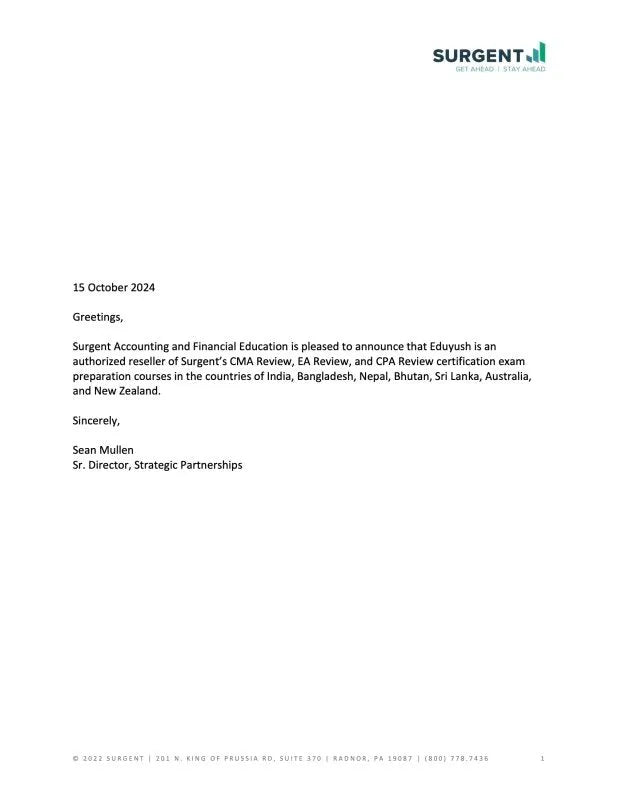CMA Performance report: How to Interpret Exam Scores
CMA Performance Report: How to Interpret Your Exam Scores
The CMA performance report is an essential tool for candidates who do not pass a part of the CMA certification. It provides detailed feedback on your performance across the various content areas, helping you identify where you need improvement for your next attempt. This report is a roadmap that guides your study efforts, allowing you to focus on weak areas while reinforcing your strengths.
What is the CMA Performance Report?
The CMA Performance Report is issued to candidates who do not pass one or both exam parts. It breaks down your performance across key content areas, describing where you did well and where you fell short.
The report categorizes your performance as
- satisfactory,
- marginal, or
- unsatisfactory.
Use this feedback to adjust your study focus when preparing for a retake.
For more details on how your scores are calculated, check out our guide on CMA Exam Scoring Explained.
Components of the CMA Performance Report
The performance report is divided into the major content areas tested in each CMA exam part. For example:
Part 1 - Financial Planning, Performance, and Analytics might include:
- External Financial Reporting Decisions
- Planning, Budgeting, and Forecasting
- Performance Management
- Cost Management
- Internal Controls
- Technology and Analytics
Part 2 - Strategic Financial Management covers:
- Financial Statement Analysis
- Corporate Finance
- Decision Analysis
- Risk Management
- Investment Decisions
- Professional Ethics
For each content area, your performance is categorized as:
- Satisfactory (strong performance)
- Marginal (average performance)
- Unsatisfactory (below-average performance)
This breakdown makes it easier to see your weaknesses so you can prioritize those areas in your study plan for your next attempt.
How to Interpret the CMA Performance Report
Assess Your Overall Performance
Your CMA performance report will categorize each section as satisfactory, marginal, or unsatisfactory. If most of your areas are marked as "satisfactory," you were likely close to passing, and with targeted improvements, you could pass on your next attempt.
- Satisfactory: You performed well in this area. These sections still require revision but should be outside your primary focus.
- Marginal: Your performance was average, and these sections need more attention to boost your score.
- Unsatisfactory: This indicates significant weaknesses and should be a top priority in your next study plan.
Want to know more about when you’ll receive your results? Visit our detailed page on CMA Exam Results Timeline for a breakdown of when and how results are released.
Pinpoint Weak Areas
Use the report to identify sections where you performed poorly. For instance, if your score in Corporate Finance was unsatisfactory, that’s a clear indicator you need to revisit concepts such as capital budgeting, working capital management, and financing options. Prioritize studying those areas before your next exam.
Use your performance report to plan your retake effectively. For tips on when to schedule your next exam, read our guide on CMA Exam Dates and Scheduling.
Target Your Study Plan
The CMA performance report is a valuable tool for customizing your study approach. Rather than reviewing all topics equally, you can focus on the areas marked as marginal or unsatisfactory, ensuring you invest your time where it matters most. Combine this with reinforcing areas marked as satisfactory to maintain performance across all sections.
Evaluate MCQ vs. Essay Performance
Although the report doesn’t differentiate between your performance in the multiple-choice questions (MCQs) and the essay section, you can infer which section might need more work. For instance, if you performed poorly in areas often tested in the essay portion, such as Corporate Finance or Financial Statement Analysis, you may need to improve your ability to apply concepts in writing and calculations.
Example: Interpreting a CMA Performance Report
Let’s say you receive the following results for Part 2 - Strategic Financial Management:
- Financial Statement Analysis: Marginal
- Corporate Finance: Unsatisfactory
- Decision Analysis: Satisfactory
- Risk Management: Marginal
- Investment Decisions: Satisfactory
- Professional Ethics: Satisfactory
In this case:
- Your primary focus should be Corporate Finance, where your performance was unsatisfactory.
- Financial Statement Analysis and Risk Management also need significant improvement, but they are secondary to Corporate Finance.
- Reinforce your vital areas like Decision Analysis and Investment Decisions to maintain high performance in those sections.
This approach ensures that your study plan is efficient and targets the areas that will impact your overall score the most.
When Will You Receive the CMA Performance Report?
You will receive your CMA performance report about six weeks after the exam results are released. Initially, you will receive a pass/fail notification, and the detailed performance report will follow later if you do not pass. This delay allows the IMA to review and categorize your performance across all exam areas carefully.
Critical Takeaways for Using Your CMA Performance Report
- Identify Weak Areas: Focus on sections marked as unsatisfactory or marginal to boost your overall score.
- Customize Your Study Plan: Use the feedback to create a targeted study plan that emphasizes your weakest areas while maintaining your strengths.
- Revisit Essay Strategies: If your weak areas include topics typically tested in essays, improve how you explain and apply concepts in written form.
- Plan: Incorporate regular practice exams and mock essays into your study routine to ensure you’re prepared for the MCQ and essay sections.
- Seek Help: Consider using specialized CMA review courses or tutors to focus on difficult content areas if needed. This extra support can make a big difference in your preparation.
If you need help developing a study plan based on your CMA performance report, visit our detailed guide on top tips to pass the CMA exam.
FAQs About the CMA Performance Report
What is the CMA performance report?
The CMA performance report is a detailed analysis provided to candidates who do not pass the exam. It breaks down your score by content area and indicates whether your performance in each area was strong, average, or weak.
How do I receive my CMA performance report?
If you do not pass, your CMA performance report will be sent about six weeks after your exam results are released. It provides feedback on your strengths and weaknesses.
How should I use the CMA performance report to prepare for a retake?
Focus on the content areas marked as unsatisfactory or marginal. Use these insights to adjust your study plan and more effectively target weak areas.
Does the performance report include a breakdown of MCQ and essay scores?
The performance report does not separate the MCQ and essay section results. However, it provides insights into content areas where you may have struggled, which can indicate where improvement is needed.
Conclusion: Maximize Your Performance with the CMA Performance Report
The CMA performance report is invaluable for any candidate preparing for a retake. Analyzing the detailed feedback lets you identify weak areas, customize your study plan, and improve your overall performance. Focus on the sections marked as marginal or unsatisfactory, and strengthen your essay approach if necessary.
With a clear understanding of your report and a strategic study plan, you’ll be better prepared for your next exam attempt and well on your way to earning your CMA certification.
Surgent CMA Review course
Pass the CMA USA Exam with a 95% Success Rate
✅Smart, AI-Driven Study Plan for Faster Learning
✅Comprehensive Study Materials & Expert Support
✅Now Available at India pricing at 70% Off
Frequently Asked Questions About the CMA US Certification Course
What is the CMA course, and how does it differ from other accounting certifications?
The CMA US course is a globally recognized certification program for finance and accounting professionals, focusing on strategic financial management, budgeting, and performance management. It’s ideal for those looking to advance in corporate finance roles.
How difficult is the CMA exam, and what are the pass rates?
The CMA exam is known for being challenging, with an average global pass rate of around 45%. The exam consists of two parts: Part 1 focuses on Financial Planning, Performance, and Analytics, while Part 2 covers Strategic Financial Management. Each part has a mix of multiple-choice questions and essay questions, which test both theoretical knowledge and practical application. Most candidates find Part 1 more quantitative and Part 2 more strategic, with both requiring thorough preparation.
How long does it take to complete the CMA US course?
Most candidates complete the course in 6-18 months, depending on study time and preparation. The two exam parts can be scheduled separately, allowing for flexible pacing.
How long do you have to pass both parts?
CMA aspirants have three years to successfully complete both components of the exam from the day they join their program. With ample time available, success is well within reach!
How much time should I dedicate to studying for the CMA exam?
Most candidates report studying between 150 to 200 hours for each part of the CMA exam. If working full-time, this could translate to around 3-5 months per part, depending on your existing accounting knowledge and study habits. A structured study schedule, covering each section systematically and including ample time for practice questions and revision, is essential for success.
CMA resources links
Here are all the links to CMA Resources
- ACCA vs CMA
- CMA Certification
- CMA Exam Centre. Locations
- CMA US online course
- CMA Exam Dates: Complete Guide for your Test in 2025
- CMA Exam Essay Questions: How to Master Them
- CMA Exam fees. Updated for 2024
- CMA Exam High Yield Topics: Where to focus
- CMA Exam Pass Rates: Insights and Tips
- CMA Exam Passing Score: How to Pass with ease
- CMA Exam pattern: Your Complete Guide
- CMA Exam Tips: How to Pass on Your First Try in 2025
- CMA Part 1 Formula Sheet
- CMA Part 1 or Part 2: Which to Take First?
- CMA Performance report: How to Interpret Exam Scores
- CMA Study Plan: How to Master the Exam in 2025
- CMA Syllabus Changes 2025: Key Updates
- CMA US CPE requirements: Complete Guide
- CMA US Eligibility Requirements
- CMA USA Course details: Comprehensive guide
- CMA USA Results: What to Expect in 2025
- CMA vs CA: Which is Better for Your Career?
- CMA vs CPA: Choosing the Right Path for Your Career
- CMA Work Experience Requirement
What are the career prospects for CMA holders, and how does it impact salary?
The CMA credential can open doors to various managerial and executive positions in finance, accounting, and corporate management. Common roles include financial analyst, management accountant, CFO, and financial controller. Salary expectations vary by region, but CMAs generally earn around 30-50% more than their non-certified peers. In the U.S., the average salary for CMAs can range from $80,000 to $150,000 annually, depending on experience and location.
Can I pursue the CMA certification while working full-time?
Yes, many candidates complete the CMA while working full-time. Time management is crucial, and it may involve studying during evenings and weekends. Employers often support CMA candidates by providing study resources, financial assistance, or time off for exam preparation. Reddit users recommend setting realistic goals and maintaining a consistent study routine to balance work and study effectively.
How is the CMA viewed outside the United States?
The CMA is recognized in over 100 countries and is highly regarded in various industries, particularly in regions like the Middle East, China, and India. It is especially valuable for professionals interested in multinational corporations or companies with a global presence. In some countries, CMA-certified professionals may earn equivalent or even higher salaries than CPAs or local accounting professionals.
Is the CMA course worth it if I already have a CPA or another accounting certification?
Many professionals with a CPA or another accounting certification pursue the CMA to gain expertise in management accounting and strategic decision-making. The two credentials can complement each other well, with the CPA focusing more on auditing and tax and the CMA emphasizing corporate finance and strategy. The choice depends on career goals—if you're aiming for managerial roles in corporate finance, the CMA is highly advantageous.
How is the job market for CMAs affected by automation and AI?
While automation and AI have affected traditional accounting roles, they have increased the demand for management accountants who can interpret data and contribute to strategic decision-making. CMAs are well-positioned to leverage these technologies, as their training covers data analytics and performance management, making them valuable assets in organizations seeking to innovate and optimize processes.
What happens if I fail a part of the CMA exam?
If you fail a part of the CMA exam, you can retake it during the next testing window. The IMA offers the exam in three testing windows each year: January-February, May-June, and September-October. Preparing for a retake may involve identifying areas of weakness, revising study materials, and perhaps trying different resources or study methods.
Who is eligible for the CMA US course?
To be eligible, candidates must have a bachelor’s degree from an accredited institution, two years of relevant professional experience in financial or management accounting, and IMA membership.













Leave a comment